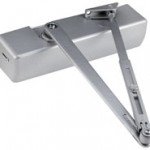UL Listed Door Closer, we have written about these before, but we get so many inquires about so and so number Listed Door Closer I thought it might be a good time to revisit it. The following is an explanation on what Underwriters Laboratories does and what the UL Listed Door Closer means.
Underwriters Laboratories (UL) is a government-approved company that carries out testing and certification to ensure products meet safety specifications. These standards are based on probable hazards associated with the product. UL vigorously tests a sample of the product to determine how it reacts in each hazardous situation. If the manufacturer has proven it can create products that meet UL’s stringent safety requirements, it gets approved to carry the UL Listed mark.
Consumers, contractors and builders subsequently look to Underwriters Laboratories fire ratings when purchasing and using building materials. UL fire ratings for exterior walls and interior surfaces indicate which materials in a variety of categories are fire-resistant to a degree that agrees with National Fire Protection Association codes and standards as well as local building and fire codes.
Central to the matter of UL fire ratings, building codes and fire codes is the safety of a building’s inhabitants and inhabitants of nearby edifices.
UL fire ratings for walls also help to indicate what architectural features and materials to use in conjunction with fire-rated walls, such as doors. Ratings enable builders to install doors and windows with compatible UL fire ratings. Manufacturers disclose such ratings in product descriptions, and products bear a UL-rated or UL-certified sticker that indicates all relevant information to the builder, contractor or consumer.
The NFPA devises many of the codes and standards that local building code divisions uphold. UL is a global independent safety science company that tests building materials for both commercial and residential purposes. Since UL fire ratings adhere to NFPA standards and local building codes, the UL fire rating potentially indicates to building inspectors that materials within the building and exterior walls comply with local building and fire codes.
With this being said we usually find a number like 320G Listed Door Closer on all door closers. In this case the 320G Listed Door Closer is most likely a LCN Door Closer with a mechanical arm, meaning it does not hold the door open when pushed all the way open. We would find a different number on a LCN Door Closer with a hold open arm.
The Label 236N Listed Door Closer is usually found on Corbin Russwin Door Closers. Your closer might be a Corbin or a Russwin, but in 1994 Corbin and Russwin merged there product lines into Corbin Russwin.
Here is a list of numbers we know about, which is just a small sample but you will get the idea.
149A Listed Door Closer – Norton and Yale Door Closers
236N Listed Door Closer – Corbin Russwin Door Closers
320G Listed Door Closer – LCN Door Closers
615R Listed Door Closer – International Door Closers
669G Listed Door Closer – Dorma Door Closers
803H Listed Door Closer – Sargent Door Closers
805H Listed Door Closer – Sargent Door Closers
1038G Listed Door Closer – LCN Door Closers
R6684 Listed Door Closer – International Door Closer
R7483 Listed Door Closer – Global Door Controls
The above information should help you to an extent, but sometimes the easiest thing to do is measure the center to center hole spacing on your current door closer, and then visit our Robert Brooke and Associates Commercial Door Hardware Door Closer Information page to find a door closer that matches your hole spacing.
]]>
